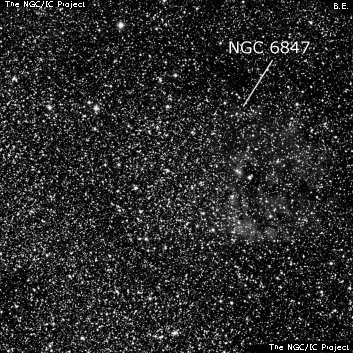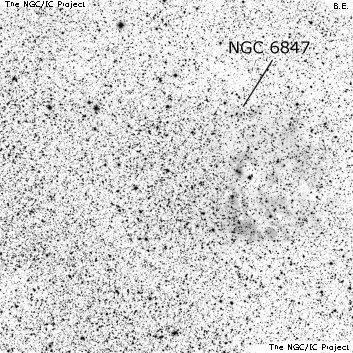NGC/IC Project Restoration Effort
(This is a very very beta version)
NGC6847


Basic Information
Location and Magnitude
Right Ascension: 19:56:48.0
Declination: +29:18:0
Constellation: CYG
Visual Magnitude:
Historic Information
Discoverer: Herschel W.
Year of discovery: 1784
Discovery aperture: 18.7
Observational
Summary description: Neb, r
Sub-type: *Cloud
Corwin's Notes
=====
NGC 6847 may be the star cloud and HII region roughly a degree north and 45
seconds west of WH's single position. Earlier I had this just 30 seconds
west. That, however, assumes WH's object was a cluster -- but see his
description, given below, where this is clearly noted as a "nebulous" object.
This identification was first suggested by Wilhelm Tempel in 1871 in a paper
about his discovery of a comet at the Brera Observatory in Milan (my thanks to
Wolfgang Steinicke for sending a note about this).
There is certainly nothing obvious near WH's place, and Tempel's objects could
be the ones he saw. They are immersed in a fairly large star cloud in the
Milky Way, which might have led to his comments about the surrounding area.
His full description, given in the sweep and repeated by Dreyer in the
Collected Papers of 1912, reads, "A resolvable nebulous patch; there are great
numbers of them in this neighborhood like forming nebulae; but this is the
strongest of them."
Another possibility is raised by Dreyer's note in the NGC, "Not noticed by
d'A, who has 2 observations of GC 5947 = m 403 [= NGC 6842, a planetary]."
Is N6842 the object that WH saw? It is just 2 minutes of time preceding and
3 arcmin south of his position. There may be enough stars around the nebula
to lead to WH's description, so this may be a candidate.
Checking the sweep, I find no problems with the reduction, or with the adopted
position of 12 Cygni, the comparison star. To make Tempel's objects work,
WH's offsets from 12 Cygni need to be at least 17m 06s east and 7 arcminutes
north. These would translate to a clock reading of 19 44.2 to 19 44.4 instead
of 19 44.9, and an index reading of exactly "0" rather than 1 deg 0 arcmin.
These are certainly possible errors, but I do not like having to suggest two
errors in a single observation; in general, one error is the expectation
unless a comparison star is misidentified.
I also checked the sweep for other objects referred to 12 Cygni. The object
immediately preceding NGC 6847 is NGC 6834 for which WH's RA is 25 seconds too
large, though the Dec/NPD is only 4.3 arcminutes too large. The near half-
minute error in this cluster's position suggests that a similar error in the
RA of NGC 6847 is due to some systematic problem rather than an accident of
observation or transcription. This leaves the 1 degree error in the index
reading as perhaps the only "blunder" here, if Tempel's suggestion is, in
fact, the correct explanation.
Two other possibilities are nearby on the POSS prints. First is a clump of
stars about 20 arcmin north of WH's position. The second is another clump
about 55 arcmin south. Neither of these, however, has "great numbers" of
similar clumps nearby.
Dreyer notes that Bigourdan found no nebulosity at WH's place, though he
searched the area four times. His one micrometric observation (I haven't
reduced it) probably points at a double or multiple star. There are many of
them around.
Finally, using the POSS1 overlays, I thought that this might be identical to
"NGC 6846" (which see). However, the overlay copies RNGC's 2 degree error
in the declination for N6846 so that it lands on top of the cluster and HII
region I noted at the beginning of this story. N6846 is not these objects,
though as I said, N6847 might just be.
All in all, I am not quite as convinced as I was earlier that Tempel has
turned up the correct object. After all, WH included this as a nebula in his
catalogue, not as a star cluster, which is what most of the objects in the
area would look like at the eyepiece. Perhaps that is what is needed here.



